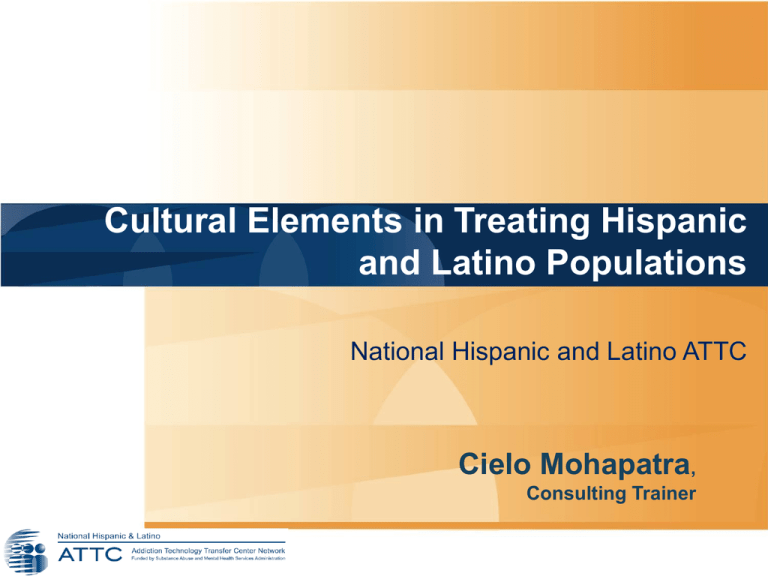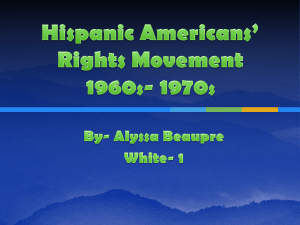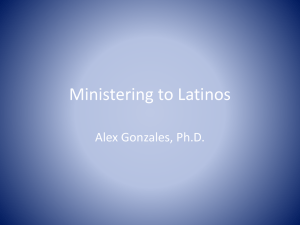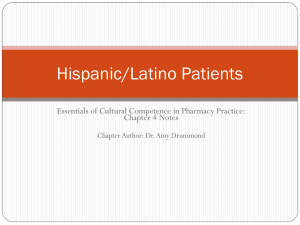
Cultural Elements in Treating Hispanic
and Latino Populations
National Hispanic and Latino ATTC
Cielo Mohapatra,
Consulting Trainer
Objectives
• Understanding culturally appropriate
concepts and definitions in treating Latino
and Hispanic populations
•
Identifying cultural elements that impact
health disparities and barriers to treatment
in the Latino and Hispanic communities
•
Strengthening personal and organizational
cultural competence in the treatment and
recovery process for diverse populations
Who is Hispanic?
Hispanic refers to language or Spanish
speaking
Consider if you and/or your ancestry
come from a country where they speak
Spanish
To keep it simple: Anyone who says
they are and/or Nobody who says they
aren’t
Sources: Pew Research Center, 2009; http://www.diffen.com/difference/Diffen:About
Who is Latino?
Latino refers to geography, people from
Latin America
Caribbean (Puerto Rico, Cuba,
Dominican Republic), South America
(Ecuador, Bolivia, Colombia, Peru, etc.)
Central America (Honduras, Costa Rica,
etc.)
Cultural Concepts and Definitions
• Acculturation: the process of adopting the cultural
traits or social patterns of another group or host
culture
• Assimilation: Changes in language preference,
adoption of common attitudes and values in common
social groups and/or institutions, loss of separate
identification of one group as they come in contact
with their host society
n
Cultural Concepts and Definitions
• Bias: An unfair act or policy stemming from
prejudice; to influence unfavorably or detrimentally
(American Heritage Dictionary, 1992)
• Cultural Self-Awareness: Understanding the
assumptions and values upon which one’s own
behaviors and worldview rest.
Cultural Concepts and Definitions
• Diversity: Multiplicity of beliefs, traits, dispositions,
belief systems, values, norms, behaviors, traditions,
religions, social practices, orientations, languages,
etc., that may be said to characterize minorities
various groups of people
Cultural Concepts and Definitions
• LEP: “Limited English Proficiency” speakers when
referencing to those who may require or benefit from
interpreter and/or translation services in a health
care services delivery setting
Cultural Concepts and Definitions
• LGBTQ: Abbreviation of the terms
Lesbian/Gay/Bisexual/Transgender/Questioning
Cultural Concepts and Definitions
• Minority: The smaller in number of two groups
forming a whole; a racial, religious, political,
national, or other group in comparison to a different
larger group of which it is a part of (dominant
culture)
Cultural Concepts and Definitions
• Subculture: Ethnic, regional, economic, or social
group exhibiting characteristic patterns of behavior
sufficient to distinguish it from others within an
embracing culture of society
Other Subculture Groups
• People with disabilities (physical and mental
disabilities)
• Urban, suburban, rural, and frontier cultures
• Sexual orientation (asexual, heterosexual, gay,
lesbian, bisexual and questioning)
• Gender identity (female, male, gender variant,
questioning, intersex, transgender)
• Limited English Proficiency (LEP) in any culture
• Socioeconomic status (poverty, educated vs.
uneducated)
• Deaf & Hard of Hearing
Health Equity
Individuals from diverse cultural
backgrounds are unable to attain their
highest level of health.
OMH, 2011
Health Disparities
Source: www.healthypeople.gov
Healthy People 2020
Health Disparity
“A particular type of health
difference that is closely linked
with social, economic, and/or
environmental disadvantage”
Source: www.healthypeople.gov
Disparities in Hispanics and Latinos
• Underrepresented in professions related to behavioral
health
Source: Chapa & Acosta, 2010; Clemens-Cope, Kenney, Buettgens, Carroll & Blavin, 2012
Disparities in Hispanics and Latinos
• No access to primary care provider
(insurance or cultural barriers)
• More likely to rush to emergency department
or hospital fro urgent care
• Less likely to have proper communication
with providers
• Less likely to obtain preventive and specialty
services
• Less likely to experience improved health
outcomes
Source: ASHTO, 2011
Mismatch between Needs and the Service
Models Available
• Reduced access
• Low retention rates
• Absence of effective community
strategies
Source: Caribbean Basin and Hispanic ATTC, 2006
Culture
• The sum of attitudes, customs, and beliefs that
distinguishes one group of people from another
• Culture is transmitted, through language, material
objects, ritual, institutions, and art, from one
generation to the next (Dictionary.com, 2014)
Americanization
• Used initially in the latter part of the 19th century and
early part of the 20th century
• Referred to a social movement whose goal was to fully
assimilate immigrants into American society
• Referred to the process by which “immigrants are
transformed into Americans”
Source: Graham & Koed, 1993; Huebner, 1906
Bicultural or Biculturalism
• Integration of two or more cultural identities
• Bilingual, “Spanglish”
• Political views
Cultural Competence
• Includes being able to recognize and respond to health-related
beliefs and cultural values, disease incidence and prevalence, and
treatment efficacy
• Culturally competent care is a set of behaviors, attitudes and
policies that enable effective work with individuals from different
cultures.
Source: OMH, 2001
Culture and Treatment
Considerations of common culture
characteristics for Hispanics and Latinos
in the U.S. in the context of drug
treatment
Culturally and Linguistically Appropriate
Services in Health Care
The enhanced National Standards for Culturally and
Linguistically Appropriate Services in Health Care are
issued by the USDHHS’ Office of Minority Health to
advance health equity, improve quality and eliminate
health care disparities by establishing a blueprint to
implement culturally and linguistically appropriate
services.
Source: OMH, 2013
Common Cultural Themes for Hispanic
and Latinos in the United States
•
•
•
•
•
Family or familia (familismo)
Respect or respeto
Personal relationships or personalismo
Trust or confianza
Spirituality or espiritualidad
Source: Falicov, 1998; Santiago-Rivera et.al, 2002, Pajewski & Enriquez, 1996 &
Bracero, 1998
Familismo-Definition
“A cultural value that involves individuals’
strong identification with and attachment to
their nuclear and extended families, and
strong feelings of loyalty, reciprocity, and
solidarity among members of the same
family”
Source: Marín & Marín, 1991
Familismo
•
Traditionally, Hispanic and Latinos include
many people in their extended families, not
only parents and siblings, but grandparents,
aunts, uncles, cousins, close friends, and
godparents of the family's children.
•
Family involvement often is critical in the
health care of the patient.
Source: Santiago-Rivera, Arredondo & Gallardo-Cooper, 2002
Respect
•
Implies a mutual and reciprocal deference, and
dictates appropriate deferential behavior towards
others based on age, sex, social position, economic
status, and authority.
•
Older adults expect respect from those younger, men
from women, adults from children, teachers from
students, employers from employees.
Source: Santiago-Rivera, Arredondo & Gallardo-Cooper, 2002
Personalismo/Personal Relationships
• Formal friendliness
• Simpatía- kindness
Personal Relationships/Personalismo
Hispanic and Latinos expect health providers to
be warm, friendly, and personal, and to take an
active interest in the patient's life.
Source: Santiago-Rivera, Arredondo & Gallardo-Cooper, 2002
Trust
Over time, by respecting the patient's culture and
showing personal interest, a treatment provider can
expect to win a patient's trust
Spirituality
• Personal relationship that is transcendent or beyond
the self
• Powerful instrument for recovery
• Recognized as a protective factor
Spirituality
•
Providers often work within the structures of mainstream
medicine, which provides separate physical and mental
health care.
•
Hispanic and Latino culture, on the other hand, tends to
view health from a holistic point of view. This view
implies a continuum of body, mind, and spirit.
Pajewinski & Enriquez, 1996
Curanderismo
• Curanderismo is a form of folk healing that includes
various techniques such as prayer, herbal medicine,
healing rituals, spiritualism, massage and psychic
healing. It is a system of traditional beliefs that are
common in Latino communities. It is practiced in
several Latin American countries, as well as in the
U.S., particularly in the southwest. This is
according to the American Cancer Society.
Therefore, this is something that is utilized in all
health related fields including behavioral health.
Other Culture-Related Issues in
Treatment
• Immigration
• Gender roles
• Language selection and recovery
• LGBTTQ
Immigration
Represents two major sources of stress:
1. Family dislocation, fragmentation, and
reconstruction.
2. Culture change for individuals and across
generations.
Gender Roles
May be particularly difficult cases to treat
primarily because families stigmatize women in
a more complete and isolating manner than they
do male family members.
Machismo
• Significantly influences behavior and
attitudes of adolescent males during time
of identity formation.
• Distinction between the sexes.
• Includes dignity in personal conduct,
respect and respect for others.
Source: Rivera. & Rogers-Adkinson, 1997
LGBTTQ
• 17% of LGBTTQ Americans are Hispanic
• Acceptance increases through immigrant
generations
• Higher levels of substance use among Hispanic
LGBTTQ
• Immigration and homophobia
Source: Pew Hispanic Research Center, 2011, 2013; Díaz & Ayala, 2001; Hunt, 2012
Language Selection and Recovery
•
Spanish speaking or highly bilingual clients can
be assumed to possess more knowledge about
Hispanic and Latino culture and this may provide
some cultural information for more accurate
interpretation of information.
•
Never assume that a patient that speaks some
Spanish is knowledgeable about Hispanic and
Latino culture.
Culturally Competent Treatment
Services
• Involve family members
• Show respect
• Get personal
• Respect traditional healing approaches
• Encourage the asking of questions.
Involve Family Members
Allow for several family and friends to participate in a
consultation, and communicate with the group. The
patient may not be the key decision-maker for describing
symptoms, deciding among treatment options, or
complying with recommended treatment.
Show Respect
Always be respectful, and explain without
condescending. Health providers, as authority figures,
need to take seriously the responsibility and respect
conferred on them by many Hispanic and Latino patients.
Get Personal
• Lean forward
• Be comforting
• Use gestures
that indicate
interest
Respect Traditional Healing Practices
•
Hispanic and Latino clients may combine the
benefits of mainstream medicine, and traditional
healing, with a strong religious component
•
Experience of a broad definition of health to the
clinical or diagnostic setting. Respecting and
understanding their view can be beneficial in
treating and communicating with the client
Encourage the Asking of Questions
There is a cultural taboo against expressing negative
feelings directly. This taboo may manifest itself in a
patient's withholding information, not following
treatment orders, or terminating medical care.
Conclusion
•
Acknowledge common themes among
Hispanics and Latinos that may play a part in
terms of substance use, access, readiness and
recovery
•
By recognizing and addressing such themes,
counselors can be more effective in their
interventions with Hispanic and Latino
populations.
•
Explore how cultural circumstances are related
to your client’s presenting problems.
THANK YOU!
Cielo Mohapatra, BA
Consulting Trainer
National Hispanic and Latino ATTC
hispaniclatinoattc@uccaribe.edu
References
American Psychological Association (APA): Acculturation. (n.d.). Dictionary.com Unabridged.
Retrieved July 31, 2014, from Dictionary.com URL:
http://dictionary.reference.com/browse/Acculturation
Association of State and Territorial Health Officials (ASHTO), (2011). Primary Care and Health
Equity. Retrieve from URL: http://www.astho.org/Programs/Access/PrimaryCare/_Materials/Primary-Care-and-Health-Equity-Fact-Sheet/
Bracero, W. (1998). Intimidades: confianza, gender and hierarchy in the construction of
Latino-Latina therapeutic relationships. Cultural Diversity and Mental Health, 4(4)264-277
Caribbean Basin and Hispanic Addiction Technology Transfer Center. (2006). Cultural
elements in treating Hispanic popultaions: Dialogue on Science and addiction. Bayamón,
PR: Author.
Center for Substance Abuse Treatment. Addiction Counseling Competencies: The Knowledge,
Skills, and Attitudes of Professional Practice. Technical Assistance Publication (TAP)
Series 21. DHHS Publication No. (SMA) 06-4171. Rockville, MD: Substance Abuse and
Mental Health Services Administration, 2006.
Diaz, R., Ayala, G., Hein, J. & Marin, B. (2001). The impact of homophobia, poverty and
racism on the mental health of gay and bisexual Latino men: findings from 3 US cities.
American Journal of Public Health, 91(6)927-932.
Differ, All rights reserved retrieved from: http://www.diffen.com/difference/Diffen:About
Falicov, C.J. (1998). Latino families in therapy: a guide in multicultural practice. New York,
NY: The Guilford Press.
Marin G, Marin BV. Research with Hispanic populations. Newbury Park, CA: Sage; 1991.
References
Morales, E. (1996). Gender roles among Latino gay and bisexual men: Implications for family and
couples relationships. In J. Laird & R.J. Green (Eds.), Lesbians and gays in couples and
families: A handbook for therapists (pp. 272-297). San Francisco: Jossey-Bass.
National Hispanic and Latino ATTC. (2013). Cultural elements in treating Hispanic and Latino
populations (revision 2013). Bayamón, PR: Universidad Central del Caribe.
Pajewski, A., & Enriquez, L. (1996). Teaching from a Hispanic perspective: A handbook for nonHispanic adult educators. Phoenix, AZ: Arizona Adult Literacy and Technology Resource
Center.
Pew Hispanic Research Center (2013)
Pew Hispanic Reseach Center (2011). Latinos changing views on same sex marriage.
Rivera, B.D., & Rogers-Adkinson, D. (1997). Culturally sensitive interventions: Social skills
training with children and parents from culturally and linguistically diverse backgrounds.
Intervention in School and Clinic. 33(2), 75-80.
Santiago-Rivera, A.L., Arredondo, P. & Gallardo-Cooper, M. (2002). Counseling Latinos and la
familia: A practical guide. Thousand Oaks, CA: Sage Publications.
Substance Abuse and Mental Health Services Administration, Leading Change: A Plan for
SAMHSA’s Roles and Actions 2011-2014. HHS Publication No. (SMA) 11-4629. Rockville,
MD: Substance Abuse and Mental Health Services Administration, 2011.
U.S. Department of Health and Human Services, Office of Minority Health. (2013). National
Standards for CLAS in Health and Health Care: A Blueprint for Advancing and Sustaining
CLAS Policy and Practice. Retrieved from: www.ThinkCulturalHealth.hhs.gov
U.S. Department of Health and Human Services, Office of Minority Health. (2005). What is cultural
competency? Retrieved from
http://minorityhealth.hhs.gov/templates/browse.aspx?lvl=2&lvlID=11








